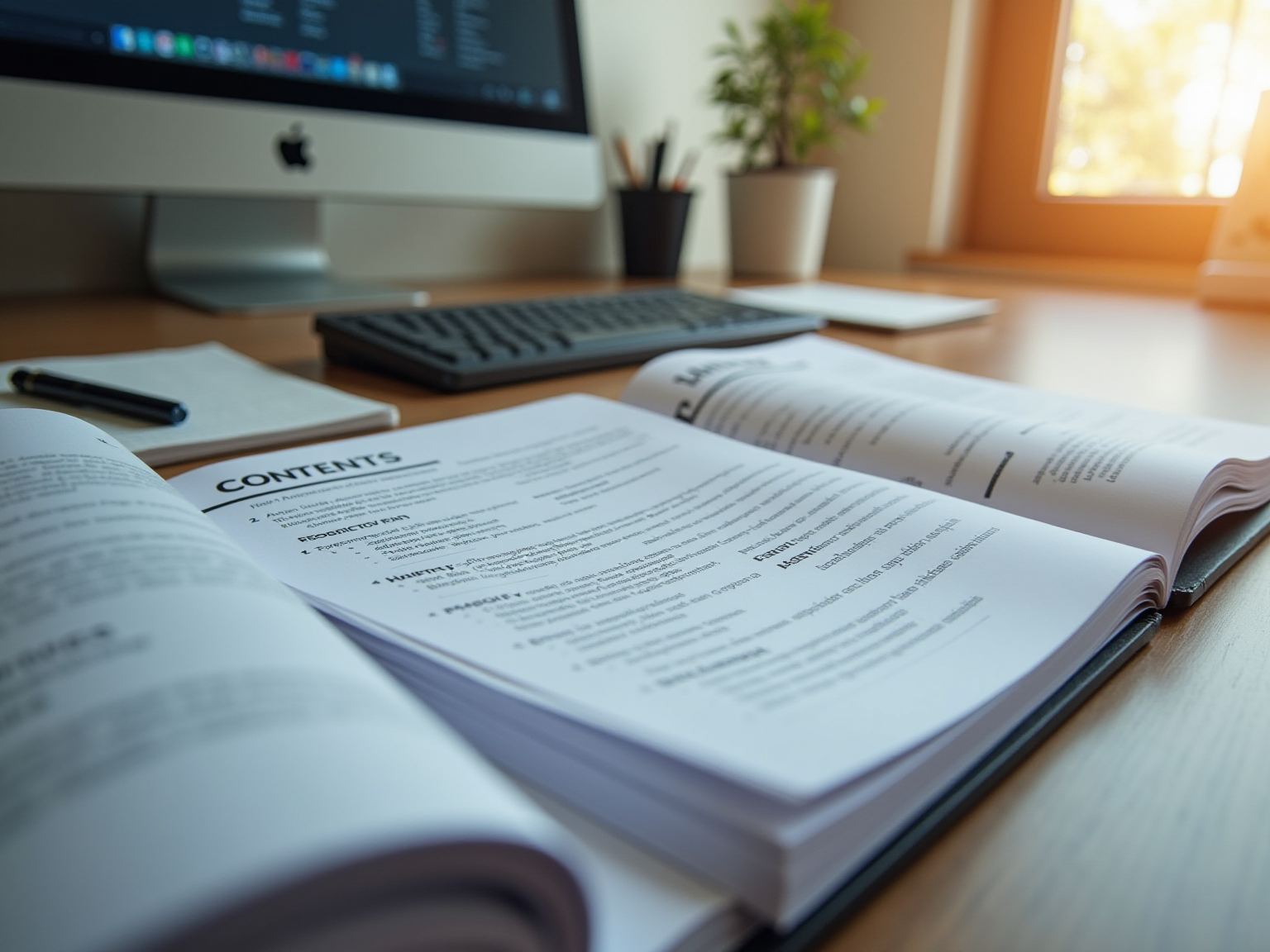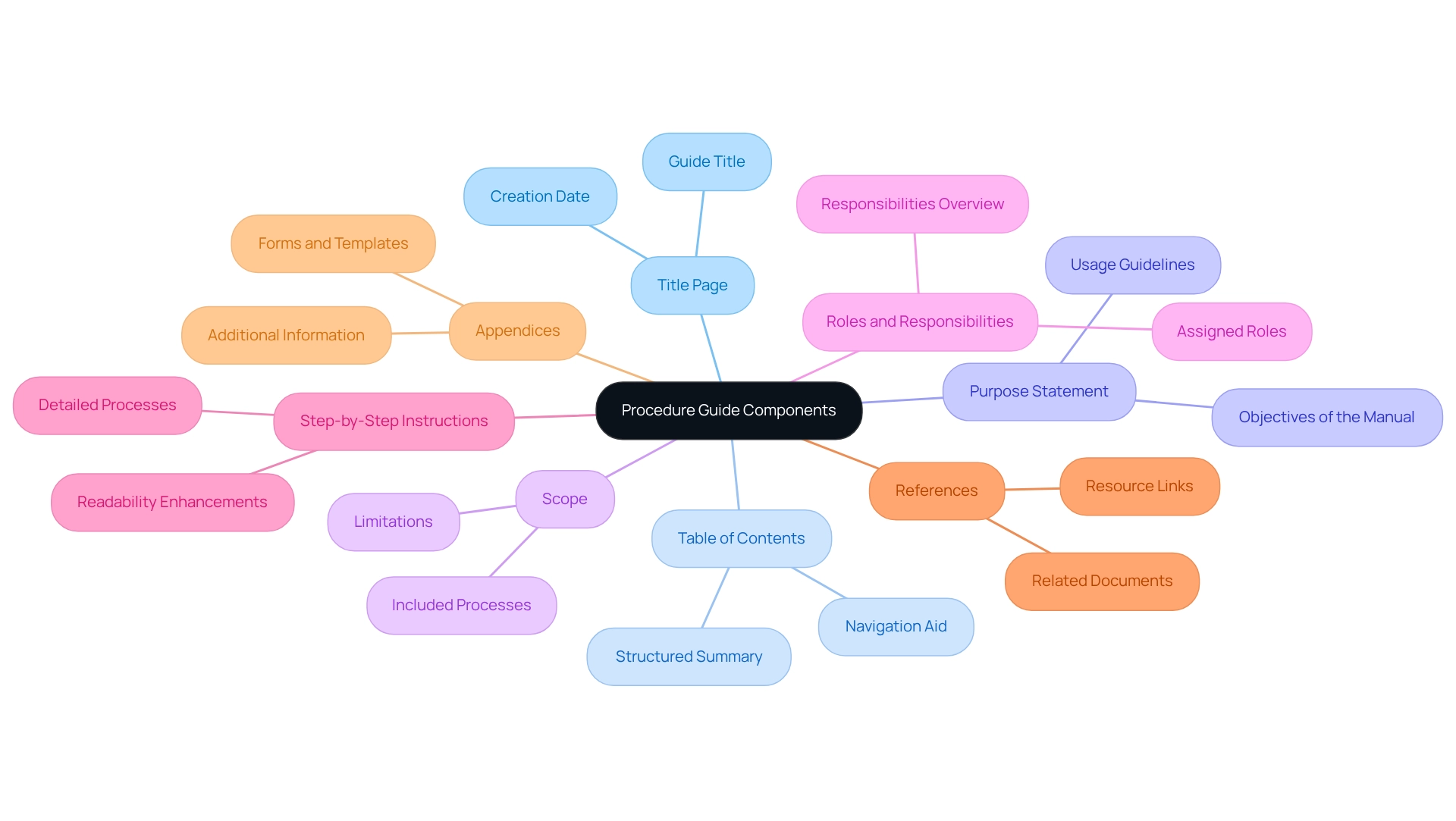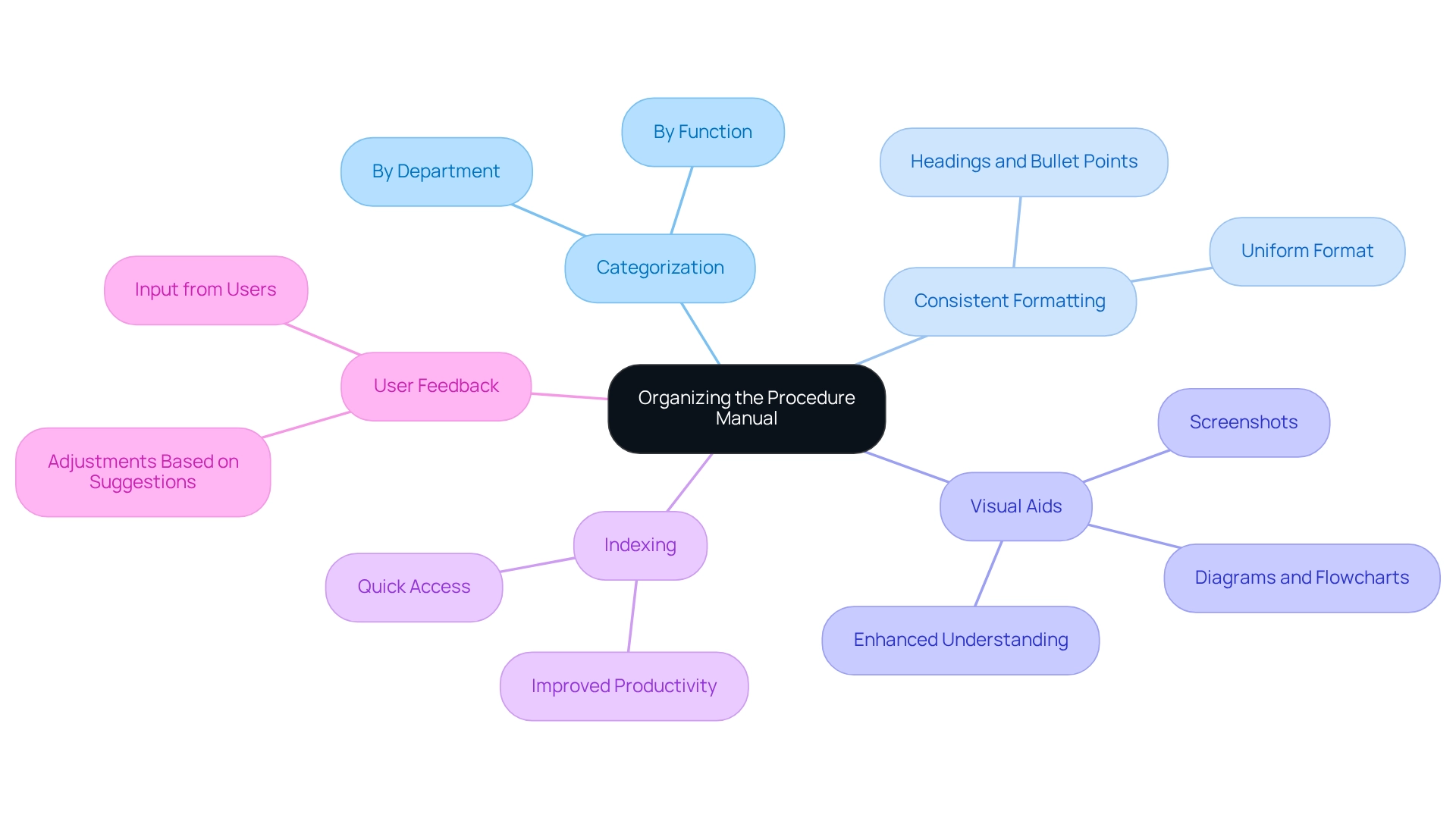
Streamlined Onboarding Processes
|
October 16, 2025
|
Create an Effective Procedure Manual for Streamlined Operations
Overview
You might be wondering how to create an effective procedure manual that really streamlines operations. Well, it’s all about outlining those standard operating protocols (SOPs) that clearly define roles and responsibilities. This not only enhances consistency but also cuts down on confusion during employee onboarding.
Speaking of which, let’s talk about the importance of having well-organized manuals. Tools like SowFlow can make updates a breeze, ensuring your documentation stays relevant and easy to access. Ultimately, this leads to improved operational efficiency, which is a win for everyone!
Key Highlights:
- A procedure manual outlines standard operating protocols (SOPs) to clarify roles and responsibilities, ensuring consistent performance.
- Well-documented protocols reduce confusion and streamline onboarding, leading to more effective employee training.
- Tools like SowFlow facilitate the creation and updating of procedure manuals, allowing for quick access to relevant documentation.
- Key components of a procedure manual include a title page, table of contents, purpose statement, scope, roles and responsibilities, step-by-step instructions, references, and appendices.
- Organizing the manual with categorization, consistent formatting, visual aids, indexing, and user feedback enhances usability.
- Drafting procedures should involve simple language, specificity, brevity, testing protocols, and examples to ensure clarity.
- Regular reviews of the procedure manual are essential for maintaining relevance, with SowFlow enabling easy scheduling, monitoring, and documentation of changes.
- Organizations that conduct frequent updates to their manuals report significant improvements in operational efficiency.
Introduction
In the ever-changing world of modern business, you might be wondering how a well-crafted procedure manual can be your secret weapon for success. This essential resource doesn’t just lay out standard operating procedures (SOPs); it also clarifies roles and responsibilities, helping everyone stay on the same page and compliant with the rules.
As companies face the hustle and bustle of a fast-paced environment, streamlining onboarding and training becomes super important. By carefully documenting procedures, organizations can boost efficiency and cut down on errors, leading to a more organized and productive workforce.
Speaking of which, innovative solutions like SowFlow can turn the task of creating and updating these manuals from a daunting challenge into a breeze, making sure your documentation is always relevant and easy to find.
Let’s dive into the key components of an effective procedure manual and explore some strategies for organizing, drafting, and maintaining it to fuel your long-term business growth.
Understand the Purpose of a Procedure Manual
You might be wondering what a guideline document really is. Well, it's a super important resource that lays out the standard operating protocols (SOPs) for various tasks in an organization. Its main goal? To clarify roles and responsibilities for everyone, making sure that performance is consistent and in line with company policies. By keeping protocols well-documented, organizations can cut down on confusion and make the onboarding process for new employees a breeze—especially in today’s fast-paced business world.
But wait, there’s more! A well-organized guide doesn’t just bring clarity; it can also slash training time and resources. Statistics show that having a solid policy and guidelines document helps with employee training and onboarding, leading to fewer errors and less time wasted. Organizations that put in the effort to create thorough guidelines often find their training is way more effective, allowing teams to concentrate on what really matters instead of grappling with unclear processes.
Now, let’s dive into how easy it can be to create and update procedure manuals with the right tools. Imagine having an instant record-keeping solution that makes this task effortless! This innovative platform lets organizations whip up user guides quickly, ensuring that the materials stay relevant in a constantly changing business landscape. Plus, with just a single command, users can pull up documentation, making everything even smoother. Case studies reveal that organizations using tools like MS Word for their procedure manuals can document processes swiftly and accurately. However, as needs evolve, this platform offers a more flexible solution that adapts to changing circumstances, enhancing process standardization and knowledge sharing.
As one expert puts it, "Ultimately, investing in a well-organized operations guide is an investment in the long-term sustainability and growth of your business." And let’s not forget about the handy templates available to help you organize , ensuring all the critical areas are covered. So, investing in a well-organized operations guide isn’t just a good idea; it’s a strategic move toward operational success!
Identify Key Components to Include
When you're developing , you might be wondering what key elements to include. Well, it's pretty straightforward, especially with SowFlow's intuitive platform that makes it easy to construct and modify your guide.
First off, you’ll want a Title Page that clearly states the title of your guide along with the date it was created. Next, a Table of Contents is essential—this provides a structured summary of your guide's contents, making navigation a breeze.
Now, let’s talk about the purpose statement. This part explains the objectives of the procedure manual and how it should be used. Don't forget to define the Scope—this outlines the processes included and any limitations. You should also outline the Roles and Responsibilities, detailing who is responsible for each item in the manual.
When it comes to the Step-by-Step Instructions, make sure to detail each process clearly and concisely. Using bullet points or numbered lists can really help with readability. The best part? SowFlow enables immediate updates, so your materials stay relevant and precise.
And what about References? Including related documents or resources can really help users understand the processes better. Finally, consider adding Appendices for any additional information, like forms or templates that could be useful.
With SowFlow, you can summon the wisdom of your documentation with just a single command, streamlining the creation process and boosting your productivity!

Organize the Manual for Clarity and Usability
To enhance clarity and usability, you might be wondering how to organize the procedure manual logically. Here are some friendly tips:
- Categorization: Group related processes under relevant headings or sections, like by department or function. This way, the manual not only streamlines navigation but also helps you find information quickly.
- Consistent Formatting: Use a uniform format for each process, with headings, subheadings, and bullet points. Consistency here significantly boosts readability, allowing you to absorb information more efficiently.
- Visual Aids: Think about integrating diagrams, flowcharts, or screenshots to visually illustrate intricate processes. Research shows that visual aids can enhance understanding and retention by up to 65%, making them super helpful in training contexts.
- Indexing: Don’t forget to include an index at the end of the guide for quick access to specific topics or procedures. A well-structured manual can really cut down the time spent searching for information, which means more productivity for you!
- User Feedback: Actively seek input from users about the document's organization. Adjustments based on their suggestions can lead to improved usability and ensure that the procedure manual meets the needs of its audience.
Now, let’s dive into how this platform enables organizations to create user guides effortlessly. It ensures that materials are not only well-organized but also easily updated. With a single command, SowFlow taps into your records, helping you avoid unnecessary meetings and simplifying the process of locating answers. Regular evaluations and revisions of the procedure manual are essential; organizations should review their documentation at least once a year to keep everything relevant and effective. A systematic method for arranging instructional documents clarifies responsibilities and prepares employees to tackle challenges efficiently. Just look at the case study "Roadmap for Day-to-Day Operations"—it shows , supported by SowFlow's solutions, positively impact day-to-day operations.

Draft Clear and Concise Procedures
To draft effective procedures that really enhance clarity and conciseness, let’s consider a few friendly guidelines together:
- Use Simple Language: You might be wondering why this is important. Well, eliminating jargon and complex terminology is key! Opt for plain language that everyone can easily understand, ensuring that all users can access the information they need right away.
- Be Specific: It’s super helpful to clearly outline each step in the process. Using action verbs and avoiding vague language ensures that your instructions are precise, which is crucial for effective implementation.
- Limit Length: Aim to keep your processes concise while still including all the essential information. Strive for brevity without sacrificing clarity—this way, you allow for quick reference and understanding.
- Test Protocols: Have your team members try out the drafted guidelines. This helps you spot any uncertainties or difficulties. Their feedback is gold for refining the documentation, making it even more effective and user-friendly.
- Include Examples: Whenever possible, throw in practical examples to show how the method should be executed. This really helps users grasp the concepts better.
Now, let’s talk about the importance of using simple language in instruction guides. Research shows that clarity in records has a direct impact on user understanding, leading to more effective execution of the procedure manual. For instance, organizations that focus on straightforward language in their manuals often report higher employee satisfaction and shorter training times. to illustrate this is Eastwoods; after refining their record-keeping practices with various tools, they saw and clarity among staff, which ultimately boosted productivity. Christine Lock, the Managing Director, even said, "All the directors and staff feel energized and sense that the company is on the brink of great achievements," highlighting the positive outcomes of clear record-keeping practices. Plus, the platform’s features make it super easy to update and modify documentation, avoiding those pesky unnecessary meetings while ensuring that policies or rules are consistently applied without exceptions. By following these guidelines and leveraging the platform’s capabilities, operations managers can create a procedure manual that simplifies processes and fosters a more organized work environment. So, are you ready to dive in and make your documentation shine?
Review and Update Regularly for Relevance
To keep the procedure manual relevant, it’s super important to have a regular review process, and guess what? Using SowFlow can really amp up this effort!
You might be wondering how to get started. First off, let’s talk about scheduling reviews. It’s a great idea to set up a timeline for periodic reviews—think annually or bi-annually—to check that the manual's content is still in line with current practices. With this handy tool, you can set reminders and automate the scheduling, making it a breeze!
Next up, assign responsibility. Designate a specific team or individual to oversee the review process. This way, there’s clear accountability for updates and maintenance. The platform makes it easy to allocate tasks and keep an eye on progress.
Now, let’s dive into monitoring changes. It’s crucial to actively track any shifts in processes, regulations, or technologies that could affect . SowFlow’s instant documentation solution keeps you updated with real-time changes, allowing for timely adjustments.
And don’t forget to solicit feedback! Regularly gathering input from users helps pinpoint areas that might need improvement or clarification. The platform really shines here, facilitating knowledge sharing so you can easily gather and apply user feedback.
Lastly, document changes. Keep a comprehensive log of modifications made during each review. This provides transparency and a clear history of how the manual has evolved. Thanks to the platform’s user-friendly interface, this documentation process is streamlined, ensuring all changes are recorded efficiently.
Regular reviews aren’t just a best practice; they’re essential for keeping the procedure manual and standard operating procedures (SOPs) effective and relevant. Statistics show that organizations that conduct frequent updates see a significant drop in operational inefficiencies. For example, Delta Dental of Arkansas shared, "What used to take an hour now takes about 30 seconds. Changes that might have taken four-to-eight hours can now be done in minutes. No programmers are involved anymore. I can make changes without pulling developers off other projects." This really highlights the efficiency gained through systematic reviews, especially when leveraging these capabilities.
Additionally, case studies like the one from the Queensland Building and Construction Commission show how crucial it is to maintain consistent language and accurate content across various offices, which can be achieved through diligent review processes. By prioritizing regular reviews and taking advantage of SowFlow's easy creation experience for user guides and instant updates, organizations can boost the relevance of their documentation. This, in turn, leads to improved operational efficiency and better knowledge management.
Conclusion
You might be wondering how a well-crafted procedure manual can really make a difference in your organization. Think of it as the cornerstone of your success—it provides clarity on roles, responsibilities, and standard operating procedures. By streamlining onboarding and training processes, these manuals not only cut down on confusion but also boost overall efficiency. Plus, with innovative solutions like SowFlow, creating and maintaining these manuals becomes a breeze, keeping your documentation relevant and easily accessible.
So, what makes an effective procedure manual? Key components include:
- A clear structure
- Concise procedures
- Regular updates
Organizing the manual logically, using user feedback, and adding visual aids can greatly enhance usability, helping employees find the information they need in no time. And let’s not forget the power of simple language and specific instructions—these foster better understanding and implementation of procedures, which in turn leads to happier, more productive employees.
Now, let’s talk about the importance of regular reviews and updates. In today’s fast-paced business landscape, keeping your manual relevant is crucial. By setting up a systematic review process and utilizing tools like SowFlow, you can easily track changes and ensure compliance with current practices. Ultimately, investing in a comprehensive procedure manual isn’t just about ticking boxes; it’s about empowering your employees and driving long-term growth and sustainability within your organization.
Frequently Asked Questions
What is a guideline document?
A guideline document is a crucial resource that outlines standard operating protocols (SOPs) for various tasks within an organization, clarifying roles and responsibilities to ensure consistent performance in line with company policies.
How does a guideline document benefit organizations?
It reduces confusion, streamlines the onboarding process for new employees, cuts down training time and resources, and leads to fewer errors, allowing teams to focus on core tasks rather than unclear processes.
What tools can help in creating and updating procedure manuals?
Innovative platforms, such as SowFlow, allow organizations to quickly create and update user guides, ensuring that documentation remains relevant in a changing business environment.
What are some key elements to include when developing a procedure guide?
Key elements include a Title Page, Table of Contents, Purpose Statement, Scope, Roles and Responsibilities, Step-by-Step Instructions, References, and Appendices.
Why is a Title Page important in a procedure guide?
The Title Page clearly states the title of the guide and the date it was created, providing essential information for users.
What is the purpose of a Table of Contents in a procedure guide?
The Table of Contents offers a structured summary of the guide's contents, making it easier for users to navigate the document.
What should be included in the Purpose Statement of a procedure guide?
The Purpose Statement should explain the objectives of the procedure manual and how it should be utilized.
How can Step-by-Step Instructions be effectively presented in a procedure guide?
Step-by-Step Instructions should be detailed clearly and concisely, using bullet points or numbered lists to enhance readability.
Why is it beneficial to include References in a procedure guide?
Including References helps users understand the processes better by providing related documents or resources.
What additional information can be included in the Appendices of a procedure guide?
Appendices can contain any supplementary information, such as forms or templates that may be useful for users.
👍
What others are liking
5 Steps to outline your ideal documentation structure
5 MINS READ
Where to start the your journey of mapping out your ideal documentation structure, aligning it with the very heartbeat of your organization?
Defining a winning level of detail in your process
3 MINS READ
What is too much detail, and what is too little? This article described in that winning level detail about what detail is enough.





